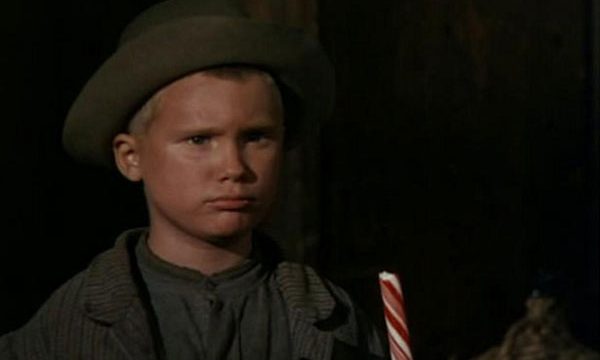Shane is a love letter to the American Dream. In fact, the movie made me catch on to the fact that it’s the second-oldest form of morality there is, one that started with the Agricultural Revolution: that what is best in life is to stake out a plot of land and exhaust yourself every day turning it into one particular beautiful thing, with the long-term aim of having children who will themselves maintain that beauty. Beloved Soluter Son of Griff has frequently remarked that he thinks the best way for modern newcomers to go through the Western genre is backwards – starting with the postmodern Westerns of Quentin Tarantino and the like, going back to the spaghetti Westerns of the 70s, and only then going back further to the white hat/black hat era of the 50s and such. I am inclined to agree if only because this loosely tracks my own journey through Westerns (though I started with Sergio Leone’s Dollars trilogy), and I suspect grounding the tropes in a way that panders to my aesthetic and moral sensibilities has given me the grounding to see the nuances of this film’s viewpoint despite my lack of personal moral engagement.
The enemy of beauty is, of course, ugliness. The bad guys of this movie – led by Ryker – are crude, tedious, and revolting. Most of the dialogue is beautiful, pulpy one-liners that are pleasant to listen to; aside from Ryker, the bad guys are just giving us petty, mean insults and stupid thoughtless pranks. Interestingly, all the violence follows suit – I know it was an influence on Peckinpah, but he managed to make crude violence into something beautiful. In Shane, the violence actually interrupts the beauty. One of the most interesting aspects of the film is that the title character is the embodiment of the concept of a Necessary Evil; he is a Messiah who sacrifices a beautiful life for himself to allow a whole community to live in beauty. Shane shooting these bastards is the least ugly option available to the characters; if Joe Starrett were to do the killin’, there is a very strong possibility that a family would be left without a husband and father.
One important part of developing a morality is choosing an Other – a enemy that represents what you are not. If you don’t define your enemy, then everyone and everything will be your enemy at once. If you define your enemy too tightly, you run the risk of inventing enemies where there are none (this is a problem I often observe my fellow leftists indulging in, turning everyone into an enemy no matter how minor their transgression). Regardless, Shane and Shane both understand that taking on an Other means, paradoxically, that you take on their characteristics. “He Who Fights Monsters” might be something thrown around thoughtlessly, but that doesn’t make it any less true; you’ll take on their language and tactics because that’s the best way to spot their weaknesses, both in that you’ll see their blind spots and in that if they use a specific tactic, they must believe it works.
The most brilliant idea in the movie – one so brilliant I am shocked it hasn’t been stolen more and so mature that I’m not that shocked it wasn’t stolen more – is the use of Joey Starret. This movie is incredibly intimate, tracking the emotions and reactions of all the characters, and the plot actively goes out of its way to include li’l Joey in as many scenes as possible to witness Shane’s actions. He’s soaking up actions he finds beautiful, and everyone – up to and including Shane himself – is increasingly horrified at his replication of Shane’s gunslinging. Destroying evil is enormously satisfying in the short term but creation is soul-restoring, and Shane can see how destruction burns up everything around it in unpredictable ways.

